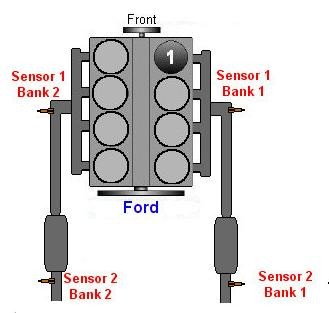The EOBD/OBDII error code P1151 indicates a “Lack of HO2S21 Switch – Sensor Indicates Lean” condition. This typically points to a problem with the upstream oxygen sensor (O2 sensor) on Bank 2, Sensor 1. This article will discuss the P1151 code in detail, including common causes, related codes, and how to diagnose and repair the issue.
What Causes the P1151 Code?
The P1151 code suggests that the upstream oxygen sensor on Bank 2 is reporting a lean condition, meaning there’s too much oxygen in the exhaust. This can be caused by a variety of issues, including:
- Faulty Upstream Oxygen Sensor (Bank 2, Sensor 1): This is the most common cause. A malfunctioning sensor can provide inaccurate readings, triggering the P1151 code. Often, this will also trigger the P0155 code (“O2 Sensor Heater Circuit Bank 2 Sensor 1”).
- Fuel System Problems: Issues with fuel pressure (either too high or too low), a clogged fuel filter, a leaking fuel injector, or a faulty fuel pressure regulator can all contribute to a lean condition.
- Vacuum Leaks: Unmetered air entering the engine through a vacuum leak disrupts the air-fuel mixture, leading to a lean condition.
- Dirty or Defective Mass Airflow (MAF) Sensor: The MAF sensor measures the amount of air entering the engine. A dirty or faulty MAF sensor can provide inaccurate readings to the engine control module (ECM), resulting in a lean mixture.
- Exhaust Leaks: Similar to vacuum leaks, exhaust leaks before the oxygen sensor can allow outside air to enter the exhaust stream, skewing the sensor’s readings.
- Faulty Powertrain Control Module (PCM): In rare cases, a faulty PCM can malfunction and incorrectly interpret sensor data or send incorrect signals to the fuel system.
Diagnosing and Repairing the P1151 Code
Diagnosing the P1151 code requires a systematic approach:
- Inspect the Upstream Oxygen Sensor (Bank 2, Sensor 1): Visually inspect the sensor for damage, corrosion, or loose wiring. You may need to consult a vehicle-specific repair manual to locate the sensor.
-
Check for Vacuum Leaks: Inspect vacuum hoses and connections for cracks, leaks, or disconnections. A smoke test can be helpful in locating hard-to-find vacuum leaks.
-
Test the Fuel System: Check fuel pressure using a fuel pressure gauge. Inspect for leaking fuel injectors or a faulty fuel pressure regulator.
-
Clean or Replace the MAF Sensor: Remove the MAF sensor and clean it with MAF sensor cleaner. If cleaning doesn’t resolve the issue, consider replacing the sensor.
-
Inspect for Exhaust Leaks: Check for exhaust leaks, particularly upstream of the oxygen sensor.
- Test the PCM: If all other components check out, the PCM may be faulty. This should be diagnosed by a qualified technician with the proper diagnostic equipment.
Replacing the Oxygen Sensor
Replacing the upstream oxygen sensor is often the solution for the P1151 code. It is a relatively simple procedure:
-
Disconnect the Battery: Disconnect the negative battery terminal to prevent electrical shocks.
-
Locate the Oxygen Sensor: Consult a repair manual for the exact location.
-
Remove the Old Sensor: Use an oxygen sensor socket or wrench to remove the old sensor. Penetrating oil may be necessary to loosen a seized sensor.
- Install the New Sensor: Apply anti-seize compound to the threads of the new sensor and install it. Tighten to the manufacturer’s specified torque.
-
Reconnect the Battery: Reconnect the negative battery terminal.
-
Clear the Codes: Use an OBDII scanner to clear the error codes.
-
Test Drive: Test drive the vehicle to ensure the code does not return.
Conclusion
The EOBD/OBDII error code P1151 indicates a potential problem with the oxygen sensor or fuel system. Addressing this issue promptly is crucial for maintaining optimal engine performance and fuel efficiency. While replacing the oxygen sensor is a common fix, thorough diagnostics are essential to pinpoint the root cause and prevent recurring problems.

